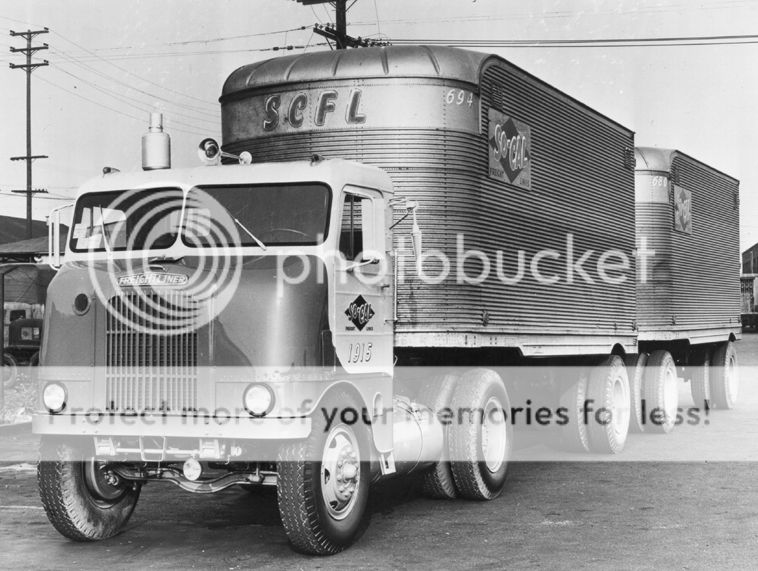Things I've Learned In Training
Topic 8852 | Page 1

Good stuff! I love reading about people's experiences.
> Stay on top of paperwork, by the end of the day, it's super hard to remember what I did or where I was that morning!
> Put things away as soon as I am done using them. Clean up/wipe down things immediately. That small space gets really messy in a hurry.
> Sometimes moving the tandems all the way forward will get me in or out of a tight spot, them move 'em back.
Tandems:
Tandem Axles
A set of axles spaced close together, legally defined as more than 40 and less than 96 inches apart by the USDOT. Drivers tend to refer to the tandem axles on their trailer as just "tandems". You might hear a driver say, "I'm 400 pounds overweight on my tandems", referring to his trailer tandems, not his tractor tandems. Tractor tandems are generally just referred to as "drives" which is short for "drive axles".
Tandem:
Tandem Axles
A set of axles spaced close together, legally defined as more than 40 and less than 96 inches apart by the USDOT. Drivers tend to refer to the tandem axles on their trailer as just "tandems". You might hear a driver say, "I'm 400 pounds overweight on my tandems", referring to his trailer tandems, not his tractor tandems. Tractor tandems are generally just referred to as "drives" which is short for "drive axles".

> Stay on top of paperwork, by the end of the day, it's super hard to remember what I did or where I was that morning!
> Put things away as soon as I am done using them. Clean up/wipe down things immediately. That small space gets really messy in a hurry.
> Sometimes moving the tandems all the way forward will get me in or out of a tight spot, them move 'em back.
Good stuff. I don't pull any trailers with sliding tandems, but I can see how that can help.
Tandems:
Tandem Axles
A set of axles spaced close together, legally defined as more than 40 and less than 96 inches apart by the USDOT. Drivers tend to refer to the tandem axles on their trailer as just "tandems". You might hear a driver say, "I'm 400 pounds overweight on my tandems", referring to his trailer tandems, not his tractor tandems. Tractor tandems are generally just referred to as "drives" which is short for "drive axles".
Tandem:
Tandem Axles
A set of axles spaced close together, legally defined as more than 40 and less than 96 inches apart by the USDOT. Drivers tend to refer to the tandem axles on their trailer as just "tandems". You might hear a driver say, "I'm 400 pounds overweight on my tandems", referring to his trailer tandems, not his tractor tandems. Tractor tandems are generally just referred to as "drives" which is short for "drive axles".
> Binoculars come in handy - when I'm in a new location, especially with a huge lot, the binos allow me to find the correct "drivers" door, read the sign so I bring in everything I need, and look to see where I'm going before I commit. Sounds lazy, but when the weather is bad, or time is tight, it makes a difference! Oh, of course, I'm pulled over and stopped before I whip out the binos. And definitely NOT for use in truck stops! CREEEEPY! I see more than I want to there without the binos.
> Binoculars come in handy - when I'm in a new location, especially with a huge lot, the binos allow me to find the correct "drivers" door, read the sign so I bring in everything I need, and look to see where I'm going before I commit. Sounds lazy, but when the weather is bad, or time is tight, it makes a difference! Oh, of course, I'm pulled over and stopped before I whip out the binos. And definitely NOT for use in truck stops! CREEEEPY! I see more than I want to there without the binos.
Download Google Earth on your phone or tablet. It's amazing what a street view can show you in regards to a shipper or receiver.
Shipper:
The customer who is shipping the freight. This is where the driver will pick up a load and then deliver it to the receiver or consignee.
New Reply:
New! Check out our help videos for a better understanding of our forum features

















Preview:








 TT On Facebook
TT On Facebook
So I just finished my second week of training. At the halfway point, I feel like I have learned a lot, but I know I have a ton more to learn, practice, and get better at.
A month of training seemed like a long time before I got started, but now, it's going to be over in a blink of an eye. This week I drove 2,240 miles, and that is only because we had Memorial Day off. Otherwise it would have been 2,800.
On the return trip yesterday, I started thinking about a list of things I have learned in the past 2 weeks, and here is what I came up with. It's definitely not complete, so hopefully people will add to it, and we can all have some fun with this.
>Never pass a toilet. Need I say more?
>Cold coffee is still coffee. I'm starting to see that actually finishing a cup of coffee while it is still hot is a luxury.
>Your 30-minute service break is your best friend. It's amazing how refreshing a 15 or 20 minute nap is.
>Anticipate everything and anything. I've already seen quite a collection of stupid 4-wheeler tricks.
>I'm trying to drive within my comfort zone. Sometimes, going 2 or 3 miles per hour slower saves me a lot of stress, and it's not costing any time. There are a few parts of our run that my trainer calls, "No Fly Zones."
>Driving and shifting are the easy part. Maneuvering a trailer around a tight yard is hard. Alley docking between a couple of cones is a lot different than putting a trailer in a tight spot between two other trailers.
>Be systematic, be systematic, and then be systematic some more. I'm trying to do everything the same way (the right way) when it comes to hooking up, inspections, etc.
>Don’t remember if you checked it? Climb down and walk around the truck again. An experienced driver told me this the other day. (And the extra exercise won't kill me either).
>Lower your landing gear (or raise it). I saw a veteran driver drop a trailer on the ground the other day. My trainer is beating into my head to lower the landing gear first, disconnect the lines second, and pull the pin last.
>I'm amazed how quickly 80,000 lbs. picks up speed downhill. I've been over speed a couple times already, and it wasn't on any long hills.
I know there's been more already, and I know there's a whole lot more learning to come.